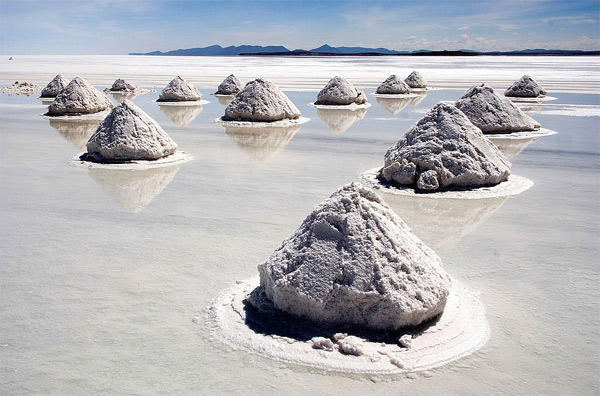Argentina, Chile and Bolivia plan to create a lithium cartel modeled on OPEC
The world's largest exporting countries of lithium are discussing the creation of a cartel on the model of OPEC, which will coordinate production volumes and will not allow prices for this metal to fall.
Lithium is a key element in the production of batteries, the demand for which is constantly growing. From 2004 to 2012, the price of a ton of lithium carbonate Li 2 CO 3 on the world market increased from $ 2,500 to $ 6,000. The cost of lithium anodes is 3-4% of the cost of a conventional Li-Ion battery, about 60% is cobalt, which is used for the production of cathodes.
So far, there has been a clear shortage of lithium on the market, and therefore great hopes were pinned on Bolivia, where 50% (!) Of global lithium reserves are concentrated in one field. This is the world's largest salt marsh Uyuni (pictured). Obviously, other exporting countries fear that Bolivia’s entry into the market may bring prices down.

')
Now the largest world exporter of lithium is Chile (44%), followed by Australia (25%), China (13%) and Argentina (11%). At the same time, Bolivia has 50% of the world's reserves of lithium, in Chile - 25% (Atacama desert), and in Argentina - about 10%.
It should be borne in mind that when the price of lithium carbonate increases by two to three times, the so-called “world reserves” automatically increase 10, 20 or 100 times , because then they will include dozens of deposits, production of which becomes profitable. The same is true for almost every other fossil. At a certain price level, even the absorption of lithium from seawater becomes profitable.
Bolivia is investing in the development of the Uyuni salt marsh about $ 900 million in three stages. At the first stage, the production of lithium carbonate will begin, at the second stage - the production of metallic lithium, and at the third stage in 2014 - the production of batteries.
Lithium is a key element in the production of batteries, the demand for which is constantly growing. From 2004 to 2012, the price of a ton of lithium carbonate Li 2 CO 3 on the world market increased from $ 2,500 to $ 6,000. The cost of lithium anodes is 3-4% of the cost of a conventional Li-Ion battery, about 60% is cobalt, which is used for the production of cathodes.
So far, there has been a clear shortage of lithium on the market, and therefore great hopes were pinned on Bolivia, where 50% (!) Of global lithium reserves are concentrated in one field. This is the world's largest salt marsh Uyuni (pictured). Obviously, other exporting countries fear that Bolivia’s entry into the market may bring prices down.

')
Now the largest world exporter of lithium is Chile (44%), followed by Australia (25%), China (13%) and Argentina (11%). At the same time, Bolivia has 50% of the world's reserves of lithium, in Chile - 25% (Atacama desert), and in Argentina - about 10%.
It should be borne in mind that when the price of lithium carbonate increases by two to three times, the so-called “world reserves” automatically increase 10, 20 or 100 times , because then they will include dozens of deposits, production of which becomes profitable. The same is true for almost every other fossil. At a certain price level, even the absorption of lithium from seawater becomes profitable.
Bolivia is investing in the development of the Uyuni salt marsh about $ 900 million in three stages. At the first stage, the production of lithium carbonate will begin, at the second stage - the production of metallic lithium, and at the third stage in 2014 - the production of batteries.
Source: https://habr.com/ru/post/138098/
All Articles